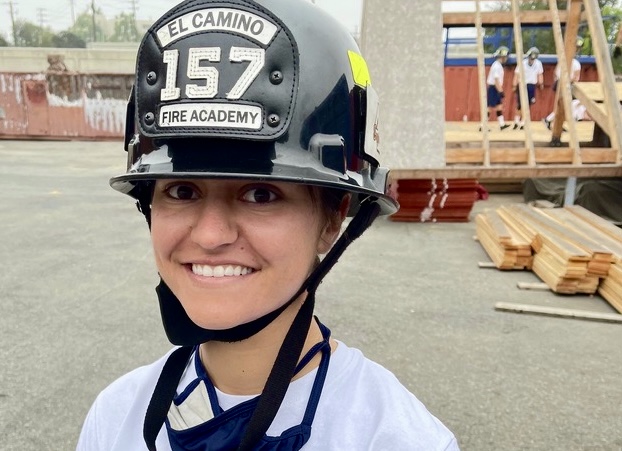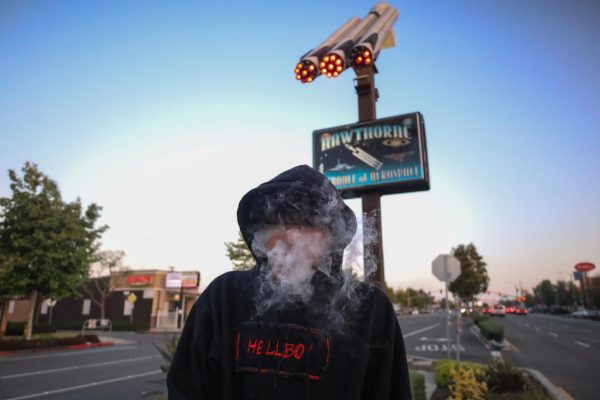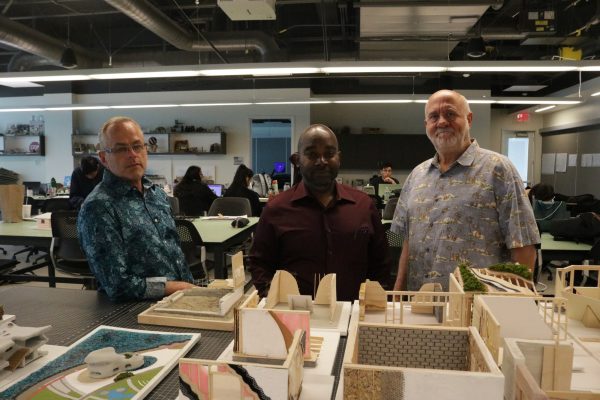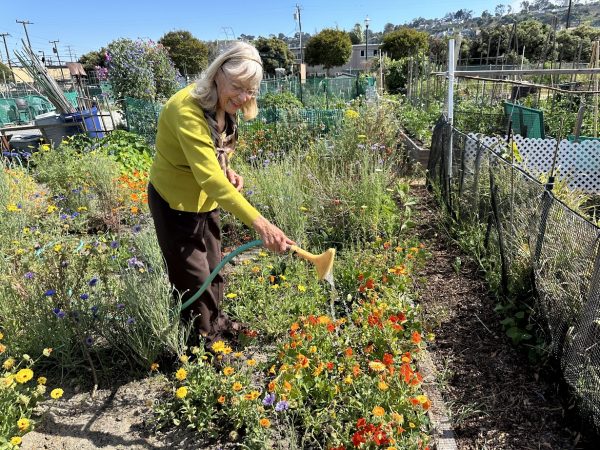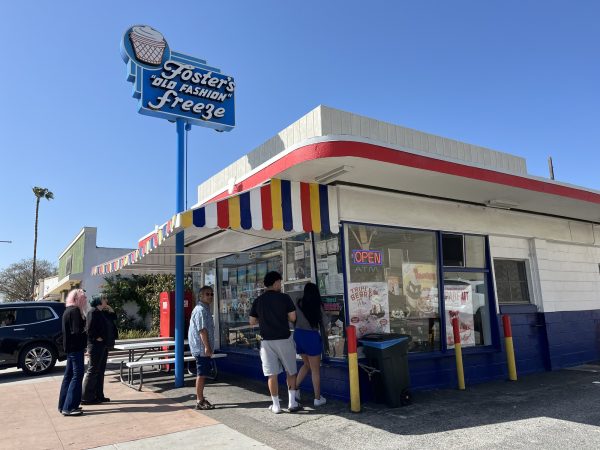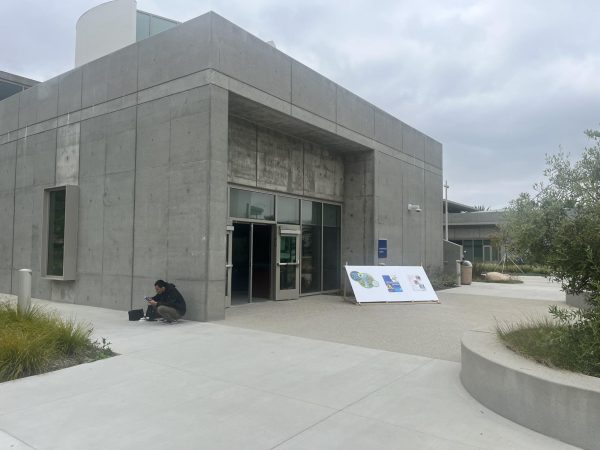ECC could become a leader in addressing gender discrimination in the fire service
Megan Kane, the only woman in the El Camino College Fire Academy’s 157th class, trains with the other students at the academy’s center in Inglewood, California on Wednesday, Nov. 2. ECC’s Fire Academy, formerly known as the South Bay Academy, has trained firefighters for more than 50 years, but women still make up less than 1% of its classes. Photo by Kim McGill/The Union
January 21, 2022
On a cool and cloudy morning in November, student Megan Kane lined up on the asphalt pavement at the El Camino College Fire Academy in Inglewood.
23 students were listening intently to six instructors and mentors. Four other students were running laps past fire trucks, equipment sheds and around a four-story rescue training tower. All Fire Academy students, mentors and faculty were men – except for Kane.
The El Camino College (ECC) Fire Academy, formerly known as the South Bay Academy, has trained firefighters for more than 50 years, but women still make up less than 1% of its classes. Currently, Kane is the only woman in the 157th fire academy class.
Kane grew up in Torrance and wants to work as a firefighter in the Los Angeles area, specializing in hazardous materials and rescue operations.
“My favorite part is saws, chain saws, forcible entry, cutting up rooves, stuff like that,” Kane said.
Women firefighters in active service represent a small minority
The first known woman firefighter was Molly Williams, a formerly enslaved woman who became a member of Oceanus Engine Company #11 in New York City in 1815.
Nancy Allen, on the other hand, is the first known female fire chief in the world, who served as a volunteer with the Cedar Hill Fire Department on Rhode Island in the 1930s and ’40s.
Today in the U.S., only about 6,200 women work as full-time, career firefighters and officers, and only approximately 150 are district chiefs, battalion chiefs, division chiefs or assistant chiefs, according to Women in Fire.
While other professions that long excluded women such as policing, the law and medicine, have seen dramatic increases in the education, hiring and promotion of women, firefighting remains a profession that lacks diversity.
Catalyst – an international organization that promotes better working conditions, treatment and opportunities for women – has tracked the growth of female participation in traditionally male jobs, and has found that societal expectations, stereotypes, lack of mentorship and sexual harassment are the major factors that cause an industry to remain male-dominated.
“Part of it has to do with firefighting’s past tradition, history and culture,” ECC’s public safety director, Chief Jeff Baumunk said. “But I think the fire service has also done a disservice to females, making it difficult – holding them to a higher standard than they do male firefighters.”
In 2013, Los Angeles Mayor Eric Garcetti promised that 5% of the Los Angeles Fire Department’s (LAFD) firefighters would be women by 2020, however, LAFD data showed that only 3.3% of the city’s firefighters were female in 2020.
In 2017, out of 2,866 firefighters in L.A. County’s Fire Department, only 45 were women.
Women account for roughly 5.5% of approximately 8,300 firefighters in CAL FIRE –the state’s fire system responsible for deploying resources to address the growing threat of larger and deadlier wildland fires.

Addressing the history of discrimination and abuse within the fire service
Across the nation and throughout L.A., the fire service has long been criticized for entrenched discrimination in the recruitment, hiring, retention and promotion of women and people of color. The fire service has also been challenged politically and in the courts for having an abusive – sometimes dangerous – culture that upholds gender and racial bias obstructs career advancement and forces people out of the profession.
On Dec. 7, Deena Lee was sworn in as chief of El Segundo’s Fire Department, the first female fire chief in South Bay history, and the only woman currently serving in that position in the Los Angeles, Ventura and Orange counties.
Lee described what it means to get hired and to stay in a career she loves.
“The challenge has been that I have to work ten times harder to prove what I can do. From pulling hose, to supervising, to being a commander on a major incident, you feel you have to prove yourself more than the men do,” Lee said.
On El Segundo’s northern border, just across Imperial Highway, the jurisdiction of the Los Angeles City Fire Department (LAFD) begins. The LAFD is undergoing a public examination of gender and racial discrimination, as well as physical and sexual assault against women and people of color within its ranks.
Kristine Larson, the LAFD’s first African American woman battalion chief and a co-founder of Los Angeles Women in the Fire Service, said before Los Angeles City Fire Commission on Oct. 5 that women and people of color were afraid of submitting complaints because of retaliation and lack of accountability.
LAFD firefighter, Katie Becker said she left the department due to the abuse she and other women suffered wrote in a complaint letter that “The LAFD’s academy broke me down and never built me back up. The tower encouraged unhealthy and selfish competition among recruits, and taught them that if someone is struggling they don’t deserve to work there.”
On Oct. 18, Larson and other women firefighters called for LAFD Chief Ralph Terrazas to resign for failing to address a culture of “rampant sexism, racism and abuse… that women and minorities routinely face.” Their demands have also been endorsed by the Stentorians representing Black firefighters and Los Bomberos representing Latinx firefighters.
What’s happening in Los Angeles is not unusual.
Succumbing to months of pressure, Terrazas announced on Jan. 18 that he would be retiring on March 26, and Garcetti nominated LAFD Deputy Chief Kristin Crowley as his replacement. If confirmed by the Los Angeles City Council, Crowley will be the first female fire chief in the LAFD’s 135-year history.
A National Report Card on Women in Firefighting reported that 85% of the women surveyed had experienced different treatment because of their gender: 65% said they knew of no process for addressing discrimination, nearly 51% had experienced shunning and isolation, 46% reported a lack of privacy in showers and dorms, nearly 32% had male colleagues who used pornography to harass or intimidate them and 30% had faced sexual advances from other firefighters or supervisors.
“When it comes to the culture, I think we need to do a better job…, to be more accepting in the fire service, and it starts from the top down,” Baumunk said.
Women bring essential skills and temperament needed in the fire service.
As an emergency medical technician, Kane answered calls at Los Angeles psyche wards and recognized how much women brought to the work. Male patients often escalated their aggression around male Emergency Medical Technicians (EMT) and police but calmed down when they saw a woman. Women patients often responded better to women EMTs as well.
“There’s calls you will go on whether medical aid or cultural calls and women are going to be able to do jobs that men can’t do,” Kane said. “They will be able to reach specific patients that men can’t.”
Ultimately, Lee says it’s good for the fire service that women are different from men. “We offer a different perspective,” said Lee. “I find women to be compassionate.”
Chief Josh Boies, ECC Fire Academy coordinator, agreed. In his experience as both a firefighter and instructor, women bring more compassion to things and add ideas that men don’t have.
“Also, at times in class, women tone the guys down, in a sisterly way as in ‘c’mon little brother,’ leveling out the testosterone,” Boies said.
Boies also described how patients may respond differently to women during emergencies than they would with men.
“Obviously, a female is usually going to feel more comfortable with another woman than with me. It’s important to have that mix on a team, to have well-rounded groups responding to calls,” Boies said.
Kane also mentioned that women firefighters bring needed diversity into the workplace.
“Women tend to be smaller, and in a confined space, we can be a major asset,” Kane said. “We are changing the culture of firefighting now seen as a macho, big-person job.”
Although her father is a battalion chief with the L.A. County Fire Department, Kane never thought about going into the fire service. Kane had a background in speech pathology when she attended the San Diego women’s fire academy – the place where she grew a passion for firefighting. Kane also volunteered in San Diego’s Girls Empowerment Camp.
“Girls come from all over the country to participate,” Kane said. “If firefighting is something you want to do, it’s completely feasible.”
According to Baumunk, ECC’s program now averages 70% of students of color, but most recent classes have had only one female student, and nearly no women participated in the past.
“I think we are doing better on getting minorities recruited,” Baumunk said. “But, if you look at the history of the fire service, it is a male-dominated profession.”
ECC is looking at best practices to increase the recruitment of female students, focusing on recruitment, exposure, mentorship, role modeling and extra training and preparation in specific areas.
Like Kane, Christine Coulson, a recent graduate of ECC’s program and a firefighter for Culver City Fire Department, never imagined being a firefighter, nor did she ever see women firefighters while growing up. Coulson was the only woman in her academy class at El Camino and is now working as an ECC instructor.
“Outreach and exposure is key,” Coulson said. “I went back this semester as an instructor at El Camino. To recruit more women personally, I try to mentor any female that’s interested and show them what they need to do.”
To reach younger girls, Coulson just organized Culver City’s first girls’ weekend fire camp for 25 different 14 to 18-year-olds in November.
For adults, ECC has started planning for a women’s fire camp to occur either monthly or bi-monthly, offering women over 18 an opportunity to experience fire service training.
“We work really hard to provide our female students with resources to help them succeed here in school, as they are looking for jobs and once they get hired as well,” said Baumunk. “We find them mentors to help them determine what they can do differently or how they can improve.”

Darnell Ray serves as a senior mentor at ECC and was a graduate of class 154 at ECC’s Fire Academy. As a Black firefighter, Ray recognizes that he saw no one in the fire service who looked like him or came from his community.
As an EMT working for an ambulance service and on film sets for three years, as well as serving as a volunteer firefighter with the Daggett Fire Department, Ray has seen people that feel more comfortable with him and it makes their health and safety outcomes more likely.
To Ray, the mentor program at ECC has benefitted him both as a student and now as a mentor.
“When you don’t see someone that looks like you, you shy away from doing something,” Ray said. “Just my face being here, that’s gonna allow people to say, ‘Wow, maybe I can do that.’ Most of us grew up seeing firefighters as a white male. Little kids are still seeing that.”
It costs $3,500 to $4,000 to go through a college fire academy, in addition to purchasing equipment and personal protective gear, and a commitment of five days a week, for sixteen weeks, Baumunk said. This can be especially difficult for women who often carry increased responsibilities for the care of children and/or elders within their families.
“We need to do a better job to keep the costs down, and to provide some equipment for free,” Baumunk said. According to Baumunk, it is also important to provide equipment and personal protective gear in all sizes, recognizing that women have always been less protected and felt less welcome with equipment that doesn’t fit.
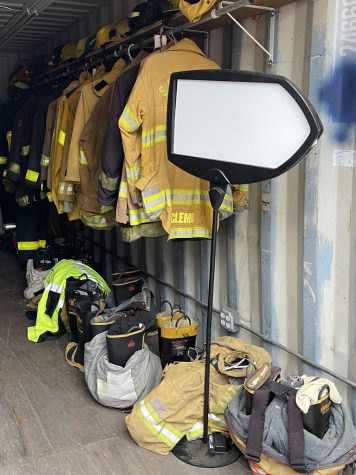
To address hiring and promotional issues, Lee and Baumunk are working to bring more women into the profession across the region as members of the South Bay Fire Chiefs’ Association. Lee, Coulson and other women firefighters are building the Women’s Fire Alliance to increase opportunities and support for women in the profession.
At ECC, students can earn 24 units completing the Fire Academy, complete 27 units in fire and emergency technology, complete their EMT certification and earn a certification as a paramedical technician.
The Fire Academy currently accepts up to 35 students in each class for its training site in Inglewood. A new facility is being built at ECC’s Torrance campus, with a possible increase in class size to accommodate up to 65 students per semester.
Working firefighters can also attend ECC for advanced training. An ECC Fire Academy application can be completed online for the spring and summer 2022 programs.

According to Coulson, having more inclusion and representation from women in the fire service will only better serve the entire community.
“The fire service is definitely known for being majority white men, historically that’s how it’s always been for more than 200 years. But the communities we serve are majority female and a lot more diverse,” Coulson said. “If someone’s hesitant about women working, it’s an uneducated assumption. When they get to know us, and they see how we work, attitudes will change.”
Editor’s note: Photos resized for readability on Saturday, jan. 22, at 9:15 p.m.


